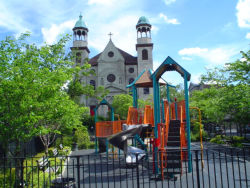Hines Park
Hines Park
The land for Hines Park was ceded to the town of Morrisania for park purposes by Gouverneur Morris in 1864. Morrisania had been the estate of the Morris family from 1670 until the 1840s, when the land was divided for sale, and new settlements were established. When the town of Morrisania was annexed to be part of New York City's 23rd ward in 1874, title to the parkland was transferred to the City. Construction of the park began at the turn of the century.
Around this time the Board of Aldermen named the site St. Augustine Park for the nearby Roman Catholic Church and school, which were founded in 1894. St. Augustine (354-430) was an African Christian who wrote a number of religious books that have molded the thought and development of Christianity. Raised with a Christian upbringing, he abandoned his faith when he began to study law and literature. While continuing his education in Milan, Augustine again embraced religion and founded a monastery at Tagaste. In 391 he was ordained a priest in Hippo. It was here that he established a religious community and became the dominant figure in African Church affairs. Augustine's written works include classics of Christian theology: Confessions, On the Trinity, and The City of God.
In 1905 the City granted $6000 for improvements of the granite steps at the south end of St. Augustine Park on 166th Street. In 1914 a park rehabilitation included the removal of the old stone wall, formerly located on the west side of the park and the installation of a rock-faced ashlar wall 74 feet long and with a stone coping 20 inches wide in its place. Further improvements were undertaken in 1916 when new soil was placed, and 3128 shrubs and 11 large trees were planted.
In 1929 the park was renamed in honor of Colonel Frank Hines (1868-1929), who served our country in Mexico and in the 105th infantry during World War I. Hines was a member of the National Guard and the Republican National Committee. Although remembered for his military career, he was also active in public affairs. He served as the Manhattan Superintendent of Public Works, a post to which he was appointed by Mayor John Purroy Mitchel. In 1930 the David Allen Post of the American Legion dedicated a small monument of travertine marble and bronze to Colonel Hines. A playground was opened in 1939. Later reconstruction of the site created two gates for an entrance, a drinking fountain, a tool shed, and a new playground with slides, swings, and a sand pit. The small park is a neighborhood gem
Check out your park's Vital Signs
Clean & Safe
Green & Resilient
Empowered & Engaged Users
Share your feedback or learn more about how this park is part of a
Vital Park System




